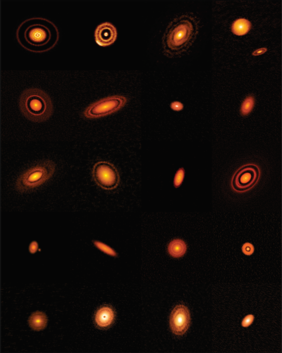Though nearly 4.000 exoplanets in orbit around distant stars are catalogued, little is known about the birth of planets and the precise cosmic recipes that spawn the wide array of planetary bodies that have already been uncovered.
To help answer these questions, a team of astronomers has conducted ALMA‘s first large-scale, high-resolution survey of 20 nearby protoplanetary disks, the belts of dust and gas around young stars in which planets are supposed to form, known as the Disk Substructures at High Angular Resolution Project (DSHARP). This has yielded stunning and spectacular structures and has given astronomers new insights into the speed with which planets can emerge.
According to the researchers, the most compelling interpretation of these observations is that large planets, likely similar to Neptune or Saturn, form much faster than current theory would allow. Such planets also tend to form in the outer reaches of their solar systems at tremendous distances from their host stars.
“The goal of this months-long observing campaign was to search for structural commonalities and differences in protoplanetary disks. ALMA’s remarkably sharp vision has revealed previously unseen structures and unexpectedly complex patterns,” said Sean Andrews, an astronomer at the Harvard-Smithsonian Center for Astrophysics (CfA) and a leader of the ALMA observing campaign along with Andrea Isella of Rice University, Laura Pérez of the University of Chile, and Cornelis Dullemond of Heidelberg University. “We are seeing distinct details around a wide assortment of young stars of various masses. The most compelling interpretation of these highly diverse, small-scale features is that there are unseen planets interacting with the disk material.”
The leading models for planet formation hold that planets are born over millions of years by the gradual accumulation of dust and gas inside a protoplanetary disk, beginning with grains of dust that coalesce to form larger and larger rocks, until asteroids, planetesimals, and in the late phase planets emerge. The DSHARP campaign was designed to study such dust particles which naturally glow in millimeter-wavelength light, enabling ALMA to precisely map the density distribution of small, solid particles around young stars.
The results are spectacular and revealed surprisingly well-defined structures, including prominent rings and gaps present at a wide range of distances from their host stars, from a few AU to more than 100 AU, which is more than three times the distance of Neptune from our Sun. They appear to be the hallmarks of planets!
These features may also explain how rocky Earth-like planets are able to form and grow. For decades, astronomers have puzzled over a major hurdle in planet-formation theory: Once dusty bodies grow to a certain size – about one centimeter in diameter – the dynamics of a smooth protoplanetary disk would induce them to fall in on their host star, never acquiring the mass necessary to form planets. The ALMA images show that Nature found a solution to this problem: apparently these dusty pebbles are trapped in rings. "Each of these rings contains many tens of Earth-masses worth of this dusty material. They are the ideal sites for new planets to be formed.” says Cornelis Dullemond from Heidelberg University, who is one of the leaders of this campaign.
The dense rings of dust we now see with ALMA would produce a safe haven for rocky worlds to fully mature. Their higher densities and the concentration of dust particles would create perturbations in the disk, forming zones where planetesimals would have more time to grow into fully fledged planets.
The results of this survey will appear in a special focus issue of the Astrophysical Journal Letters.
KONTACT:
Dr. Guido Thimm
Zentrum für Astronomie der Universität Heidelberg (ZAH)
Public Outreach
Phone +49 6221 54-1805
<link>thimm@ari.uni-heidelberg.de
ORIGINAL PUBLICATIONS:
This research is presented in a series of papers, all in the process of being published in a special issue of the Astrophysical Journal Letters:
- “The Disk Substructures at High Angular Resolution Project (DSHARP): I. Motivation, Sample, Calibration, and Overview”, Andrews, Huang, Perez, Isella, Dullemond, Kurtovic, Guzmán, Carpenter, Wilner, Zhang, Zhu, Birnstiel, Bai, Benisty, Hughes, Öberg, Ricci
- “The Disk Substructures at High Angular Resolution Project (DSHARP): II. Characteristics of Annular Substructures”, Huang, Andrews, Dullemond, Isella, Pérez, Guzmán, Öberg, Zhu, Zhang, Bai, Benisty, Birnstiel, Carpenter, Hughes, Ricci, Weaver, Wilner
- “The Disk Substructures at High Angular Resolution Project (DSHARP): III. Spiral Structures in the Millimeter Continuum of the Elias 27, IM Lup, and WaOph 6 Disks”, Huang, Andrews, Pérez, Zhu, Dullemond, Isella, Benisty, Bai, Birnstiel, Carpenter, Guzmán, Hughes, Oberg, Ricci, Wilner, Zhang
- “The Disk Substructures at High Angular Resolution Project (DSHARP): IV. Characterizing Substructures and Interactions in Disks around Multiple Star Systems”, Kurtovic, Pérez, Benisty, Zhu, Zhang, Huang, Andrews, Dullemond, Isella, Bai, Carpenter, Guzmán, Ricci, Wilner
- “The Disk Substructures at High Angular Resolution Project (DSHARP): V. Interpreting ALMA Maps of Protoplanetary Disks in Terms of a Dust Model”, Birnstiel, Dullemond, Zhu, Andrews, Bai, Wilner, Carpenter, Huang, Isella, Benisty, Pérez, Zhang
- “The Disk Substructures at High Angular Resolution Project (DSHARP): VI. Dust Trapping in Thin-Ringed Protoplanetary Disks”, Dullemond, Birnstiel, Huang, Kurtovic, Andrews, Guzmán, Pérez, Isella, Zhu, Benisty, Wilner, Bai, Carpenter, Zhang, Ricci
- “The Disk Substructures at High Angular Resolution Project (DSHARP): VII. The Planet-Disk Interactions Interpretation”, Zhang, Zhu, Huang, Guzmán, Andrews, Birnstiel, Dullemond, Carpenter, Isella, Pérez, Benisty, Wilner, Baruteau, Bai, Ricci
- “The Disk Substructures at High Angular Resolution Project (DSHARP): VIII. The Rich Ringed Substructures in the AS 209 Disk”, Guzmán, Huang, Andrews, Isella, Pérez, Carpenter, Dullemond, Ricci, Birnstiel, Zhang, Zhu, Bai, Benisty, Oberg, Wilner
- “The Disk Substructures at High Angular Resolution Project (DSHARP): IX. A High Definition Study of the HD 163296 Planet Forming Disk”, Isella, Huang, Andrews, Dullemond, Birnstiel, Zhang, Zhu, Guzmán, Pérez, Bai, Benisty, Carpenter, Ricci, Wilner
- “The Disk Substructures at High Angular Resolution Project (DSHARP): X. Multiple Rings, a Misaligned Inner Disk, and a Bright Arc in the Disk around the T Tauri Star HD 143006”, Pérez, Benisty, Andrews, Isella, Dullemond, Huang, Kurtovic, Guzmán, Zhu, Birnstiel, Zhang, Carpenter, Wilner, Ricci, Bai, Weaver, Öberg


